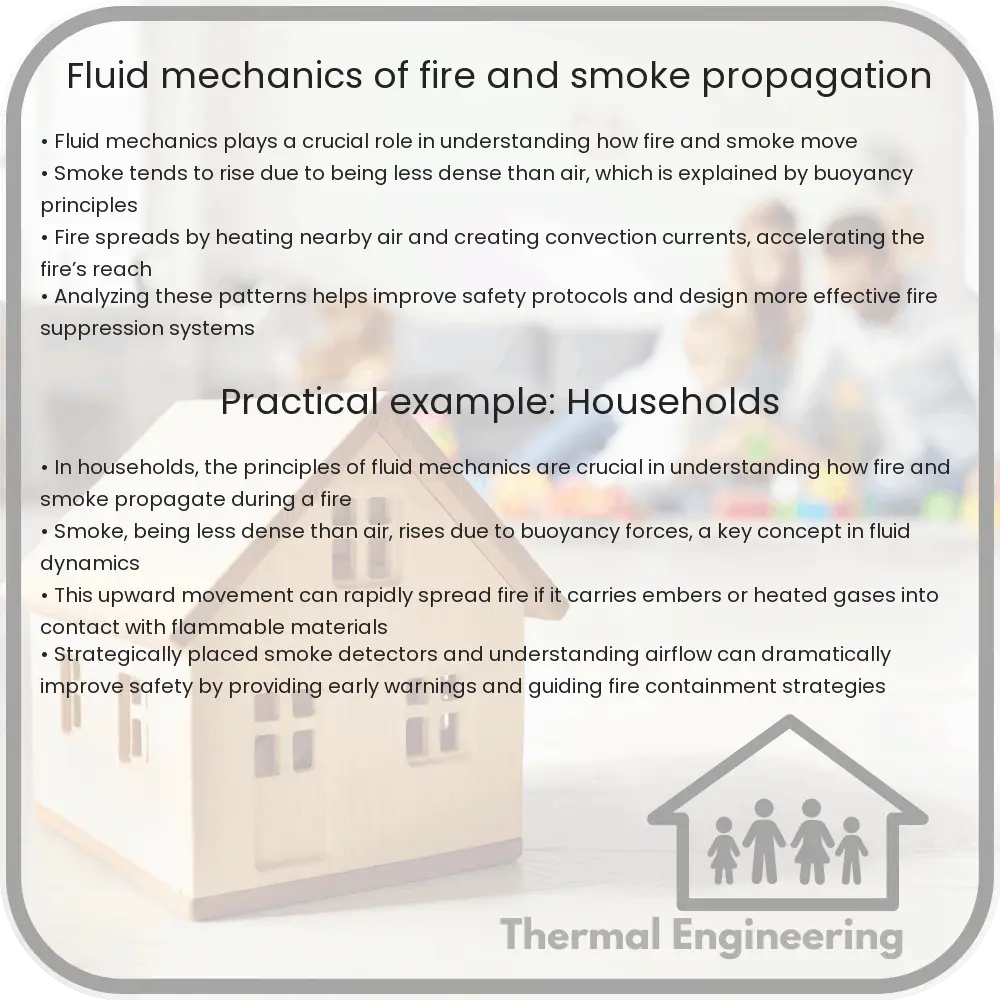Fire and smoke propagation involve complex interactions of heat, air flows, and chemical reactions, all of which can be studied through the principles of fluid mechanics. This field of engineering helps us understand how fire spreads in different environments and conditions, aiding in effective firefighting strategies and building safer structures.

Understanding the Fluid Mechanics of Fire and Smoke Propagation
Fire and smoke propagation involve complex interactions of heat, air flows, and chemical reactions, all of which can be studied through the principles of fluid mechanics. This field of engineering helps us understand how fire spreads in different environments and conditions, aiding in effective firefighting strategies and building safer structures.
Basics of Fluid Mechanics in Fire Dynamics
Fluid mechanics is a branch of physics concerned with the behavior of fluids (liquids and gases) in motion. It provides essential insights into how air movements affect fire behavior, including the spread of smoke. Two fundamental aspects of fluid mechanics in fire are buoyancy-driven flow and turbulent diffusion.
- Buoyancy-Driven Flow: Hot gases produced by fire are less dense than the cooler air surrounding them, creating an upward movement known as buoyancy. This can cause a fire to spread vertically through structures, commonly seen in scenarios like chimney effects in buildings.
- Turbulent Diffusion: The irregular, chaotic motion of gases contributes to the rapid spread of fire and smoke through increased mixing of hot gases and air. This turbulence enhances heat transfer and accelerates fire growth.
Mathematical Representation of Fire Dynamics
To predict and analyze fire and smoke behavior, engineers use mathematical models that describe the conservation of mass, momentum, and energy in fluid flows. The basic equations include:
- Conservation of Mass (Continuity Equation): \( \frac{\partial \rho}{\partial t} + \nabla \cdot (\rho \vec{v}) = 0 \) where \( \rho \) is the fluid density and \( \vec{v} \) is the flow velocity vector.
- Conservation of Momentum (Navier-Stokes Equations): \( \rho \left(\frac{\partial \vec{v}}{\partial t} + \vec{v} \cdot \nabla \vec{v}\right) = -\nabla p + \mu \nabla^2 \vec{v} + \vec{f} \) with \( p \) representing pressure, \( \mu \) the dynamic viscosity, and \( \vec{f} \) external forces like gravity.
- Conservation of Energy: \( \frac{\partial}{\partial t}(\rho e) + \nabla \cdot (\rho e \vec{v}) = \nabla \cdot (k \nabla T) + \Phi \), where \( e \) is the internal energy per unit mass, \( T \) is temperature, \( k \) is thermal conductivity, and \( \Phi \) represents the dissipation function.
Applications in Safety Engineering
Understanding the fluid dynamics of fire and smoke is critical in designing safety measures for buildings and urban areas. This includes:
- Smoke Management Systems: Effective ventilation designs can help control smoke movement, maintaining clear evacuation routes during a fire.
- Building Layout Optimization: By studying how fire and smoke propagate, engineers can design building layouts that minimize fire spread and enhance containment.
- Fire Suppression Systems: Knowledge of fluid mechanics aids in the design of more efficient sprinkler systems that can effectively target hot spots and suppress fires quickly.
Challenges and Future Directions
Despite significant advances, predicting the precise behavior of fire and smoke remains a challenge due to the chaotic nature of turbulence and the complex chemical reactions involved in combustion. Future research aims to enhance computational models and incorporate new materials and building technologies to better understand and control fire dynamics.
In conclusion, the study of fluid mechanics provides essential insights into the unpredictable and dynamic nature of fire and smoke. By continuing to integrate advanced modeling techniques and interdisciplinary research, we can improve fire safety protocols and reduce the destructive impact of fires on society.